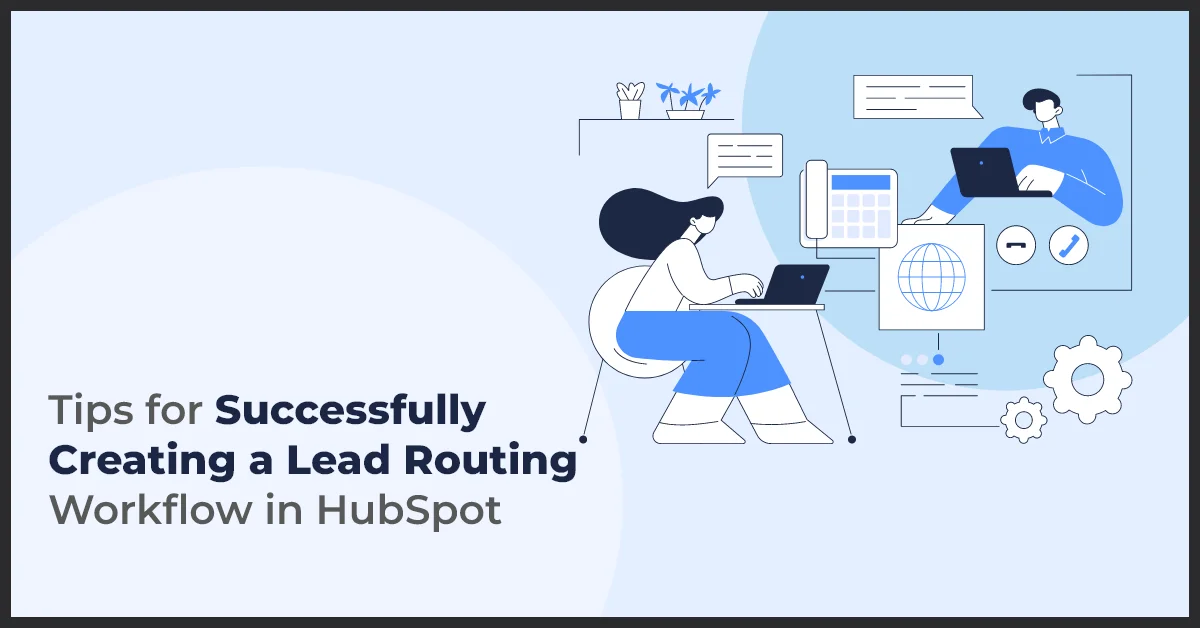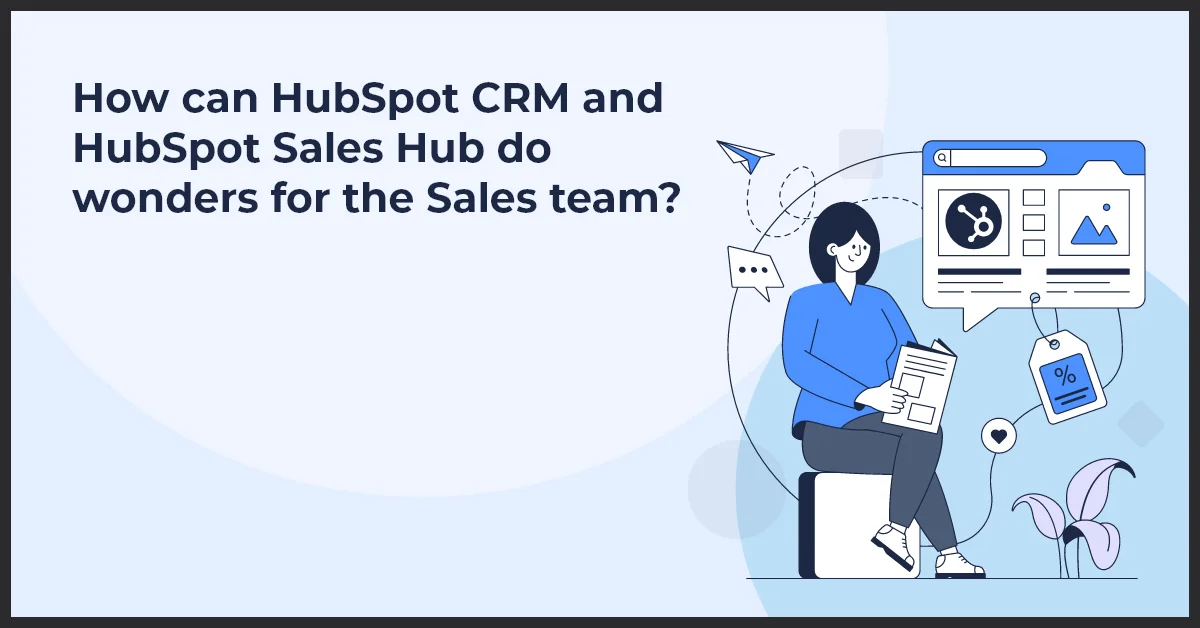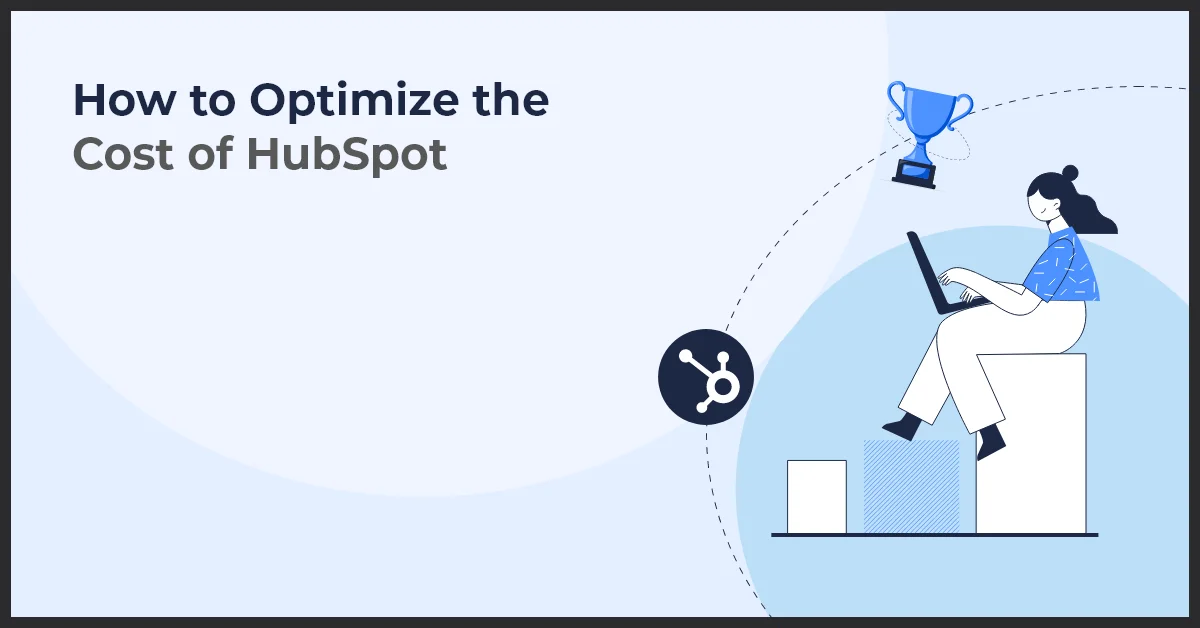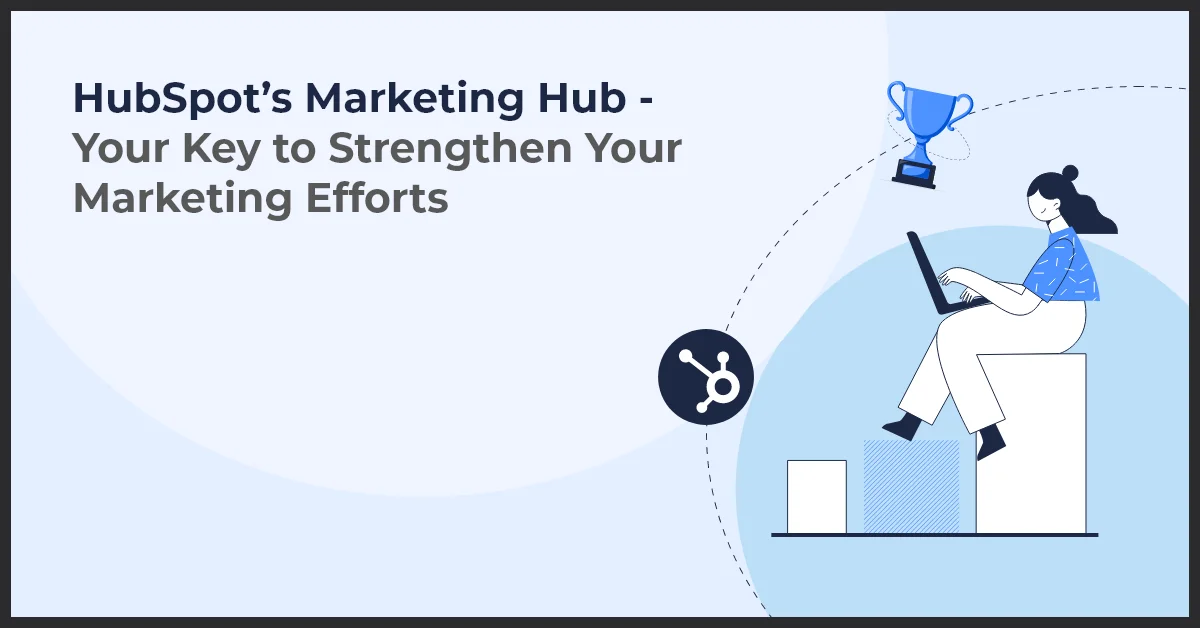Tips for Successfully Creating a Lead Routing Workflow in HubSpot

Published on: April 13, 2022
Updated on: July 05, 2024
1268 Views
- HubSpot
22 min read
In the competitive digital space, utilizing the right software, tools, and techniques is essential to ensuring that you are getting the right results.
However, using software and tools alone will not help you generate new leads or conversions. When leads enter your database, the first step should be to distribute and assign them to the concerned sales team members who could then work on them.
Even successful marketing strategies require timely actions based on the users’ journeys. This is where lead routing has a role to play.
What Is Lead Routing?
Lead routing is a tried and tested process used by marketers to allocate newly generated or potential leads to the right sales and marketing team members and get started with lead management.
Lead routing is feasible for both sales and marketing processes. Using lead routing in your sales process can mean assigning leads based on their niche or territory. Whereas in marketing, leads can be assigned based on the areas and demographics you are targeting so that the team can create tailored content to generate conversions. When automated, lead routing can help drive the productivity and efficiency of your team, and deliver a satisfactory customer experience.
What Is Workflow?
Workflow is a set of automated actions executed in a distinct and strategic manner.
Types of Workflow
Contact Engagement
The goal of any marketing campaign is to stay on the top. So, using online contact engagement, you can nurture contacts by reusing your existing content and generating conversions.
Workflow allows marketers to promote the existing content to their contacts, the ones who have never seen it before. Reusing existing content to target your contacts helps trigger actions such as page views, website visits, clicks, form submission, and purchases.
For instance, if you have an ebook on Best Software and Tools for Marketing that you have shared with your contacts, you need to wait for a week and see who has downloaded it. For those who haven’t, you can tweak your email and resend it to them again and wait for 5 to 7 days again. If they still do not proceed with a download, create a final mail, making sure to keep it engaging to see whether they take action or not.
Marketing Qualified Leads
Marketing qualified leads or MQLs aim at nurturing contacts faster by informing and educating them. In order to do this, you need to provide them with information relevant to the particular stage of the buyer's journey they are at.
For instance, send them an ebook; if they open it up, they are clearly interested in what you are offering, so your next step is to invite them for a demo. However, in case they do not download your ebook, you can share and offer to entice them like your product video or a new catalog of your products.
Sales Efficiency
The goal of the workflow is to improvise lead distribution to initiate more productive sales. You begin by assigning leads to your sales team members based on their expertise and information gathered, in order to improve sales efficiency.
For instance, you can assign leads based on the location and area the team members generate maximum from.
Re-engaging Contacts
Reconnect with the contacts that are not engaging with you. Make a list of contacts that do not respond to your emails or campaigns. Create a re-engagement workflow to reawaken their interest in the products or services you offer or you can provide them with a way out.
For instance, you can send your non-engaging contacts a list of offers that have given you a high success rate. If you see no traction or conversion in 5 to 7 days, ask them if they want to walk out.
Building Lead Routing Workflow in HubSpot
A successful lead routing workflow requires a thorough understanding of the ongoing marketing and sales work cycle, which can be cleared with some questions, like
- How do your leads enter the database? And, what happens once the leads are in the database?
- What is the right time to assign the leads to team members?
- How do you know what qualified leads are and which members of the team will use the leads?
By answering these questions, you will have a better understanding of your leads.
Creating a Workflow
Enrollment criteria and actions are two main elements when it comes to creating a workflow. Where enrollment criteria are used to check the records that will be added to the workflow and actions define the things you want the workflow to perform.
The workflow tool allows you to automate your marketing and sales processes to make your team more productive and efficient. By setting enrollment criteria you can automatically add records in the workflow and allow them to take the defined actions on your contacts, quotes, companies, etc.
In addition, workflow allows you to take actions based on the associated records, like updating the company’s information which is associated with the contact that enters the workflow.
You can create a workflow, by following the below-mentioned steps:
- Go to your HubSpot account and click on automation.
- Select workflows from the drop-down menu in the automation.
- Click on Create a Workflow in the upper right column.
- If you want to copy an existing workflow, hover over it and click Clone.
- If you want to edit an existing workflow, hover over it and click Edit.
- Select the type of workflow from the given options you want to create.
Type of workflows available:
- Contacts
- Companies
- Deals
- Quotes
- Tickets
- Custom objects
- Conversations
- Feedback submissions
Properties in HubSpot
Now, it’s time for you to identify what techniques you use in your workflow to generate better results.
As a marketer, you sure have anticipated several patterns and scenarios for the success of your campaigns. However, without a proper system and strategy in place, it becomes hard for you to bring that anticipation into reality.
Thus, to meet your goals, you can proceed by either creating a custom property or choosing the default option in HubSpot and start collecting your data into HubSpot.
Check whether or not all the properties are in place, which means looking at the processes you want to use or implement. Be certain that your workflow has the same property as assigned in the fields.
Based on the properties present, you can see if there is any modification required or if you need to optimize/troubleshoot these properties to ensure when you apply it to your workflow relevant data will occur.
However, if you do not have the right data coming through, you can follow the steps for troubleshooting:
- Open settings and then click on properties to check what properties are in use. Check whether or not these properties have relevant contacts with that value.
- Check the properties section for duplicate properties. Any redundancy should be removed. Also, ensure that you add the same properties to the workflow that are used for collecting data.
- Check for the imported leads if the desired data is being fetched or not.
- If you are getting leads from forms, check whether or not your SQL qualification forms have all the desired fields.
Organize Workflow on Spreadsheet
Having a clearer vision of what you need to work on next delivers efficiency and productivity. It applies to both, sales and marketing teams. If you need to build workflow on various factors, or if you have a massive team, you can do it easily by organizing the workflow process on a spreadsheet.
With a spreadsheet, you will have a proper understanding of what your team members will be performing next and who gets the next leads assigned. Once done with this, you can then translate it to the HubSpot.
A simple step of organizing will help you to,
- Check whether or not all your sales representatives are assigned the tasks.
- Keep a tab on the properties.
- If several team members cover the same area, you can group them quickly.
Lead Management
A. Tracking and Capturing Leads
Tracking and capturing leads effectively is essential for the success of any business. Here are some strategies to help you stay on top of your lead management:
- Regularly monitor your website and social media channels for lead opportunities.
- Utilize lead capture forms and landing pages to gather contact information from potential customers.
- Consider using lead tracking software or customer relationship management (CRM) tools to streamline the lead management process.
B. Nurturing Leads
Nurturing leads is crucial in moving them through the sales cycle. Implement these techniques to effectively nurture your leads:
- Create personalized and relevant content to engage leads and build relationships.
- Segment your leads based on their characteristics and behaviors to deliver targeted messages.
- Set up lead nurturing workflows and automation to deliver the right content at the right time.
C. Converting Leads
Converting leads into paying customers requires careful strategies and tactics. Consider the following approaches to improve your lead conversion rates:
- Implement persuasive sales techniques to convince leads of the value your product or service provides.
- Utilize best practices for closing deals successfully, such as overcoming objections and addressing customer concerns.
- Align your lead workflows with the stages of your sales pipeline to optimize conversion efficiency.
Lead Scoring
Lead scoring is an essential aspect of lead workflow that helps prioritize leads for conversion. By assigning a numerical value to each lead based on their characteristics and behaviors, businesses can identify and focus on those with the highest potential for conversion.
There are different lead scoring models and techniques that can be used, depending on the specific needs and goals of a business. These models may include demographic scoring, behavioral scoring, or a combination of both.
A. Importance of Lead Scoring in Prioritizing Leads for Conversion
Lead scoring plays a crucial role in efficiently allocating resources and efforts toward leads that are most likely to convert into customers. By prioritizing leads based on their score, businesses can ensure that their sales teams are focusing on the right opportunities and maximizing their chances of success.
B. Different Lead Scoring Models and Techniques
There are various lead-scoring models and techniques that businesses can employ. Some common approaches include assigning points for actions such as website visits, form submissions, email opens, and downloads. Others may consider factors such as industry, company size, or job title to determine lead scores.
C. Automation in Lead Scoring
Utilizing automation tools can greatly enhance the efficiency and effectiveness of lead scoring. These tools can automate the process of assigning scores to leads based on predefined criteria, eliminating the need for manual scoring and reducing human error.
1. Utilizing Automation Tools for Efficient Lead Scoring
Automation tools can streamline the lead scoring process by automatically collecting and analyzing data, assigning scores, and updating lead records in real time. This not only saves time but also ensures that leads are scored consistently and objectively.
2. Benefits and Challenges of Automated Lead Scoring
Automated lead scoring offers numerous benefits, such as increased productivity, improved lead conversion rates, and better alignment between marketing and sales teams. However, it comes with its own set of challenges, including the need for accurate data, proper implementation, and regular monitoring to ensure optimal results.
3. Techniques for Integrating Lead Scoring with CRM Systems
Integrating lead scoring with Customer Relationship Management (CRM) systems enables businesses to seamlessly manage and track leads throughout the conversion process. By integrating lead scoring data with CRM systems, businesses can gain valuable insights into lead behavior and improve overall lead management.
CRM Integration
Integrating your lead workflow with a Customer Relationship Management (CRM) system is crucial for seamless lead management and improved customer interactions. Let's explore the importance of CRM systems in lead management and the benefits of integrating them with your lead workflows.
Understanding CRM Systems
- Overview of CRM software and its role in lead management: CRM software is designed to help businesses effectively manage their interactions with existing and potential customers. It allows you to store and organize customer data, track interactions, and streamline communication.
- Benefits of integrating lead workflows with CRM systems: By integrating your lead workflows with CRM systems, you can ensure that all lead-related data seamlessly flows between your marketing and sales teams. This integration enables better collaboration, improved lead nurturing, and more targeted sales efforts.
- Best practices for streamlining lead data and customer interactions: When integrating lead workflows with CRM systems, it is essential to establish clear guidelines and processes. This includes capturing accurate lead data, automating lead assignments, and ensuring smooth data transfer to avoid any data discrepancies or communication gaps.
Marketing Automation
Introduction to Marketing Automation
Marketing automation is a powerful tool that plays a crucial role in lead workflows. It involves the use of technology to automate various marketing tasks and streamline the lead nurturing process.
By automating repetitive and manual tasks, businesses can save time, improve efficiency, and focus on more strategic initiatives. Marketing automation allows you to send personalized messages, track customer behavior, and monitor campaign performance, all in one centralized platform.
Importance of Automation in Lead Nurturing and Engagement
Automation is essential in lead nurturing and engagement because it enables you to deliver the right content to the right audience at the right time. By setting up automated workflows, you can send targeted emails, trigger follow-up actions, and provide relevant resources based on each lead's behavior and interests.
This personalized approach not only builds stronger relationships with leads but also increases the chances of converting them into customers. With automation, you can create a seamless and consistent experience across all touchpoints, resulting in higher engagement and better results.
Popular Marketing Automation Tools and Their Features
There are numerous marketing automation tools available, each with its own unique features and capabilities. Some popular options include:
- HubSpot: Offers a comprehensive suite of automation features, including lead capture forms, email marketing, lead scoring, and lead nurturing workflows.
- Mailchimp: Known for its user-friendly interface and robust email marketing automation capabilities. It allows you to create automated email campaigns, segment your audience, and track performance.
- Pardot: Salesforce's marketing automation platform, designed for B2B marketers. It offers lead management, email marketing, lead scoring, and ROI reporting.
These tools provide a range of features to streamline your marketing efforts, increase efficiency, and drive better results in your lead workflows.
Workflows for Lead Nurturing
Designing effective lead nurturing workflows is crucial in maximizing the potential of marketing automation. By mapping out the buyer's journey and identifying key touchpoints, you can create workflows that deliver the right content at each stage, nurturing leads and moving them closer to conversion.
Segmenting leads based on their interests, demographics, or behaviors allows you to tailor your messaging and provide a more personalized experience. Automation can then be used to automatically send targeted content, such as ebooks, webinars, or case studies, to the right audience, increasing engagement and driving conversions.
Optimizing marketing automation for lead engagement across various channels, such as email, social media, and website, is also critical. By integrating these channels and leveraging automation, you can create a cohesive and consistent experience for your leads, ultimately improving their overall journey and increasing the likelihood of conversion.
Lead Generation Strategies
Generating leads is an essential part of any successful business. Here are some effective strategies to help you attract and convert leads:
A. Inbound Marketing
Inbound marketing is a holistic approach that focuses on creating valuable content to attract potential customers. By utilizing SEO techniques, creating compelling content, and offering lead magnets, you can capture the attention of your target audience and generate quality leads.
- Overview of inbound marketing as a lead generation strategy
- Content creation, SEO, and lead magnet techniques for inbound marketing
- Measuring the effectiveness of inbound marketing in lead workflows
B. Content Marketing
Content marketing involves creating and distributing valuable content to attract and engage leads. By providing informative and relevant content, you can establish your brand as a thought leader and build trust with your audience. Integrating content marketing with lead nurturing and conversion tactics can help you turn leads into loyal customers.
- Leveraging content marketing to generate quality leads
- Development and distribution of valuable content to attract leads
- Integrating content marketing with lead nurturing and conversion tactics
C. Email Marketing
Email marketing is a powerful tool for lead generation and nurturing. By utilizing effective email campaigns and automation sequences, you can send targeted messages to your leads and guide them through the buying journey. Best practices for optimizing email deliverability and engagement are crucial for ensuring the success of your email marketing efforts.
- Utilizing email marketing for lead generation and nurturing
- Designing effective email campaigns and automation sequences
- Best practices for optimizing email deliverability and engagement
D. Social Media Marketing
Social media platforms offer great opportunities for lead generation. By leveraging social media, you can attract, engage, and convert leads. Techniques such as targeted advertising, engaging content, and monitoring social media performance can help you maximize your results within lead workflows.
- Leveraging social media platforms for lead generation
- Techniques for attracting, engaging, and converting leads on social media
- Monitoring and analyzing social media performance within lead workflows
E. Paid Advertising
Paid advertising options provide another avenue for lead generation. By exploring options such as PPC campaigns, display ads, and sponsored content, you can reach a wider audience and generate leads. Tracking and optimizing the ROI of your paid advertising efforts is crucial for ensuring that you are getting the most out of your investment within lead workflows.
- Exploring paid advertising options for lead generation
- PPC campaigns, display ads, and sponsored content strategies
- Tracking and optimizing paid advertising ROI within lead workflows
Lead Qualification
In the lead workflow process, lead qualification plays a crucial role in optimizing the overall efficiency and effectiveness of your lead management strategy. By assessing the suitability of leads, you can prioritize your efforts towards those with a higher potential for conversion.
Significance of lead qualification in optimizing lead workflows
Lead qualification is essential for several reasons:
- It allows you to focus your resources and efforts on leads that are most likely to convert into customers.
- By qualifying leads, you can ensure that your sales team spends their time on prospects with the highest potential value.
- It helps in minimizing wasted effort and resources on leads that are unlikely to convert.
- Lead qualification helps in aligning your marketing and sales teams by providing a clear definition of what constitutes a qualified lead.
Techniques and criteria for assessing lead suitability
When it comes to assessing the suitability of leads, there are several techniques and criteria you can consider:
- Demographic information: Analyzing factors such as job titles, company size, and industry can provide valuable insights into the potential fit of a lead.
- Engagement level: Assessing the level of interaction a lead has had with your website, emails, or content can indicate their level of interest and intention to make a purchase.
- Behavioral data: Tracking a lead's actions, such as downloads, webinar attendance, or social media engagement, can provide insights into their level of engagement and interest.
- Lead scoring: Implementing a lead scoring system can assign a numerical value to each lead based on their characteristics and actions, allowing you to prioritize leads based on their score.
- Qualifying questions: Asking specific questions during the lead generation process can help qualify leads by gathering information about their needs, budget, and timeline.
Identifying High-Potential Leads
To identify leads with the highest potential to convert, there are key indicators and signals you should look out for:
- Purchase intent: Analyzing a lead's behavior and actions can indicate their readiness to make a purchase.
- Engagement level: Leads that consistently engage with your content or interact with your brand have a higher potential for conversion.
- Fit with ideal customer profile: Evaluating how closely a lead aligns with your ideal customer profile can help determine their potential value as a customer.
- Budget and authority: Assessing a lead's budget and decision-making authority can provide insights into their likelihood to convert.
To effectively identify high-potential leads, it is important to implement lead qualification processes and scoring systems. By establishing clear criteria and guidelines, your team can efficiently prioritize and nurture leads with the highest potential for conversion.
Lead Nurturing Tactics
Lead nurturing is a crucial element in the lead workflow process. It involves building relationships with leads and guiding them through the sales funnel with targeted communication and relevant content.
A. Building Relationships with Leads
1. Strategies for building strong relationships with leads
Building strong relationships with leads is essential for successful lead nurturing. Some strategies to achieve this include:
- Regularly engaging with leads through personalized communication
- Providing valuable and relevant content that addresses their pain points
- Offering exclusive promotions or discounts to nurture their interest
- Using social media platforms to interact and build rapport with leads
2. Leveraging personalized communication and targeted content
Personalization is key in lead nurturing. By tailoring communication and content to the specific needs and interests of leads, you can establish trust and show that you understand their challenges. Some tactics for personalized communication and targeted content include:
- Addressing leads by their names in emails or phone calls
- Segmenting leads based on their demographics or behaviors to deliver more relevant content
- Sending personalized recommendations based on their previous interactions or interests
- Creating dynamic website content that adapts based on a lead's preferences or browsing history
B. Effective Communication Strategies
1. Best practices for communicating with leads throughout the nurturing process
When nurturing leads, effective communication is essential. Here are some best practices to ensure effective communication throughout the nurturing process:
- Respond promptly to leads' inquiries or requests for information
- Provide clear and concise messaging that addresses their pain points and offers solutions
- Use storytelling techniques to captivate leads and make your message relatable
- Keep a consistent tone and brand voice across all communication channels
2. Utilizing various channels (email, phone, social media) for effective communication
Utilizing various communication channels allows you to connect with leads in the ways they prefer. Here are some channels to consider for effective communication:
- Email: Sending targeted emails with valuable content and offers
- Phone: Following up with leads via phone calls to address any questions or concerns
- Social Media: Engaging with leads through social media platforms to provide information and support
Lead Conversion Strategies
Converting leads into loyal customers is the ultimate goal of any successful business. To achieve this, you need to have effective lead conversion strategies in place. Here are some proven techniques that can help you close deals and convert leads:
1. Techniques for successfully closing deals and converting leads
- Personalized Communication: Tailor your communication to the needs and preferences of each lead. This can include personalized emails, phone calls, or even in-person meetings.
- Social Proof: Showcase positive customer reviews, case studies, and testimonials to build trust and credibility.
- Offer Incentives: Provide exclusive deals, discounts, or limited-time offers to encourage leads to take action and make a purchase.
- Effective Follow-up: Consistently follow up with leads to address any questions or concerns they may have and keep them engaged throughout the conversion process.
2. Sales strategies and negotiation tactics for lead conversion
- Create a Sense of Urgency: Highlight limited availability, upcoming price increases, or exclusive offers to encourage leads to make a quick decision.
- Build Relationships: Focus on building strong relationships with leads by understanding their pain points, offering solutions, and providing exceptional customer service.
- Objection Handling: Anticipate common objections and have well-prepared responses to address them effectively.
- Negotiation Skills: Develop negotiation skills to find win-win solutions that meet the needs of both your business and the lead.
By implementing these lead conversion strategies, you can increase your chances of successfully closing deals and turning leads into loyal customers.
Reporting and Analytics in Lead Workflows
In order to ensure the success of your lead workflow, it is crucial to have a deep understanding of its performance. This is where reporting and analytics play a vital role. By closely monitoring and analyzing the data, you can gain valuable insights that will help you make informed decisions and improve your lead workflow.
Introduction to Reporting and Analytics
Reporting and analytics involve the process of tracking and measuring various metrics to understand how well your lead workflow is performing. It allows you to identify areas of improvement and make data-driven decisions.
Monitoring and analyzing lead workflow performance is essential for several reasons. Firstly, it helps you identify any bottlenecks or inefficiencies in your workflow. By pinpointing the problem areas, you can streamline your processes and ensure a smooth flow of leads.
Additionally, reporting and analytics provide you with valuable insight into the effectiveness of your lead-generation strategies. By analyzing the data, you can identify which strategies are generating the most leads and focus your efforts on those that provide the highest ROI.
Measuring Lead Workflow Performance
Measuring the performance of your lead workflow involves analyzing key metrics that provide an accurate representation of its effectiveness. These metrics can include conversion rates, lead velocity, lead quality, and customer acquisition costs, among others.
By regularly monitoring these metrics, you can evaluate how well your lead workflow is performing. For example, if you notice a decline in conversion rates, it may indicate that your lead nurturing tactics need improvement. On the other hand, a high lead velocity may suggest that your lead generation strategies are working effectively.
Extracting insights from the data is equally important. By analyzing trends and patterns, you can identify opportunities for improvement and make data-driven decisions. This continuous improvement process helps you optimize your lead workflow and maximize its effectiveness.
Conclusion
Having leads in your database is just the beginning. Assigning leads to the right members of your team is important to drive efficiency and work on them effectively, especially for companies with big teams. Leveraging lead routing workflow in HubSpot will result in growth and improved productivity of your overall team.
Our team of certified HubSpot experts is always ready to go above and beyond in their marketing efforts and is experienced in helping our customers get the most out of their marketing automation. We at Growth Natives provide you with full-funnel marketing techniques and lead routing strategies that will help your business to excel.
Frequently Asked Questions
A lead routing workflow in HubSpot is an automated process that determines how leads are assigned and distributed among sales representatives or teams based on predefined criteria such as lead source, industry, location, or lead score.
Lead routing is important in HubSpot because it ensures that leads are promptly and accurately assigned to the appropriate sales representatives or teams, maximizing the chances of conversion and providing a seamless experience for leads.
In HubSpot, a lead refers to a contact who has shown interest in your products or services by providing their contact information through a form, email subscription, or other means. Leads are typically at the top of the sales funnel and require further nurturing before they are ready to make a purchase. On the other hand, an opportunity in HubSpot represents a qualified lead that has progressed further down the sales funnel and is considered more likely to convert into a customer. Opportunities are associated with potential deals or sales transactions and may include details such as deal amount, expected close date, and deal stage.
Workflows in HubSpot are automated sequences of actions that can be triggered by certain events or conditions. They are used to streamline and automate various marketing, sales, and customer service processes, saving time and increasing efficiency. Here are some reasons to use workflows in HubSpot:
- Lead Nurturing: Workflows can be used to nurture leads by sending them targeted emails, content, and offers based on their behavior, interests, and stage in the buyer’s journey.
- Lead Scoring and Qualification: Workflows can help automatically score and qualify leads based on their engagement with your content and interactions with your website or sales team.
- Lead Routing: Workflows can route leads to the appropriate sales or support representatives based on criteria such as location, industry, or lead score.
- Customer Onboarding: Workflows can be used to onboard new customers by sending them welcome emails, tutorials, and resources to help them get started with your product or service.
Engagement and Retention: Workflows can help engage and retain customers by sending them personalized messages, offers, and surveys based on their behavior and preferences.



